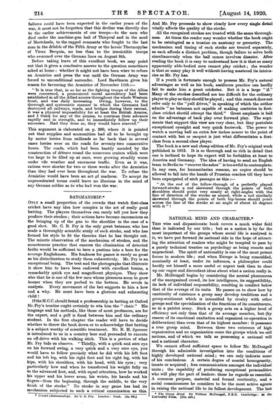BATSMANSHLP.* ONLY a small proportion of the crowds that watch
first-class cricket have any idea how complex is the art of really good batting. The players themselves can rarely tell you how they produce their strokes ; their actions have become unconscious as the bringing up of the gun to the shoulder in the case of a good shot. Mr. C. B. Fry is the only great batsman who has made a thoroughly scientific study of each stroke, and who has formed his style to fit the theories that he has thought out. The minute observation of the mechanism of strokes, and the monotonous practice that ensures the elimination of detected faults would be sufficient to turn a pastime into a bore for the average Englishman. His fondness for games is rarely as great as his disinclination to study them exhaustively. Mr. Fry is an exceptional being. The text and the photographs that illustrate it show him to have been endowed with excellent brains, a remarkably quick eye and magnificent physique. They show also that he is one of the few men whose pleasures seem to grow keener when they are probed to the bottom. He revels in analysis. Every movement of the bat suggests to him a how and a why. He must have been a glorious and exhausting child !
If theM.C.C. should found a professorship in batting at Oxford Mr. Fry's treatise ought certainly to win him the " chair." His language and his methods, like those of most professors, are for the expert, and a gulf is fixed between him and the ordinary student. In the first chapter the reader will have to decide whether to throw the book down or to acknowledge that batting is a subject worthy of scientific treatment. Mr. R. H. Spooner is introduced to us in a country lane and persuaded to execute an off-drive with his walking stick. This is a portion of what Mr. Fry bids us observe. " Thirdly, with a quick and sure eye on his forward swing, a very quick and a very sure eye, you would have to follow precisely what he did with his left foot and his left leg, with his right foot and his right leg, with his hips, with his shoulders, with his head, with his eyes ; very particularly how and when he transferred his weight fully on to the advanced foot, and, with equal attention, how he worked his upper and his lower arms, his wrists, his hands and his fingers—from the beginning, through the middle, to the very finish of the stroke." No stroke in any game has had its mechanism subjected to such a critical examination as this.
• Cricket (Bateniattehip). By C. B. 1ry. London : Nash. (4s. bd.]
And Mr. Fry proceeds to show clearly how every single detail vitally affects the quality of the stroke.
All the reoognized strokes are treated with the same thorough- ness. At times the reader may wonder whether the book ought to be catalogued as a treatise on anatomy or geometry. The mechanism and timing of each stroke are treated separately, as each affords a distinct problem, though failure to solve both simultaneously when the ball comes involves disaster. After reading the book it is easy to understand how it is that so many apparently able-bodied men cannot play cricket ; the wonder is that so many play it well without having mastered its intrica- cies as Mr. Fry has.
If a youth is fortunate enough to possess Mr. Fry's natural advantages as well as his book, assiduous practice can hardly fail to make him a great cricketer. But it is a large " if."
Many of the strokes described are too difficult for the ordinary player to play as they should be played ; and this remark does not refer only to the "pull drives," in speaking of which the author admits " no batsman not capable of making centuries in first- class cricket should attempt the third." Great emphasis is laid on the advantage of back play over forward play. The argu- ments that support this view are very clear, but they postulate exoeptional eyesight and very quick footwork. The power to watch a moving ball an extra few inches nearer to the point of contact with bat or racquet is just what differentiates a first- class from a second-class player.
The book is a new and cheap edition of Mr. Fry's original work published in 1912. It is so thorough and so rich in detail that one is inclined to hope its export will be forbidden at least to America and Germany. The idea of having to send an English team to Berlin to "recover the ashes" is too awful to contemplate.
In any case, for humanitarian reasons, no copies should be allowed to fall into the hands of Prussian coaches till they have been expurgated of such passages as this :-
" At the end of the follow-through of a perfectly played forward-stroke a rod skewered through the points of both shoulders should point very nearly at right-angles with the line of direction of the stroke as aimed, while a rod similarly skewered through the points of both hip-bones should point across the line of the stroke at an angle of about 45 degrees with it " !


































 Previous page
Previous page